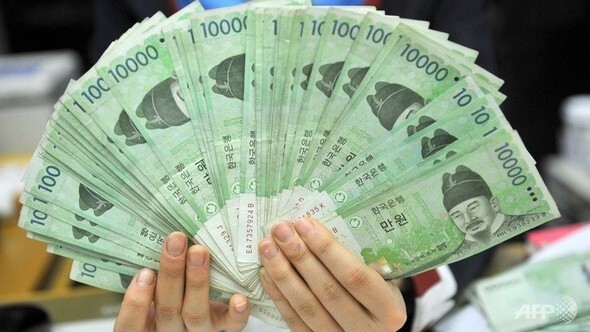hankyoreh
Links to other country sites 다른 나라 사이트 링크
S. Korean government carrying out more currency swaps

By Kwon Eun-jung, staff reporter
Currency swaps are undergoing an evolution.
Called “negative exchange accounts” by some, the swaps of the past typically involved exchanges with key currencies like the US dollar and Japanese yen in times of foreign exchange crises. Now the focus is shifting, and more and more exchanges are taking place with emerging and resource-rich countries.
Experts said the swaps are designed to take care of two problems: the effects of increasing foreign reserve holdings while reducing the risks associated with the US dollar, which has been volatile since the financial crisis of 2008.
This month, the Bank of Korea (BOK) and the South Korean government signed currency swap agreements with three countries. On Oct. 12, a 10.7 trillion won (US$10 billion) swap agreement was made with Indonesia. A 5.8 trillion won (US$5.4 billion) agreement with the United Arab Emirates followed the next day, with another 5 trillion won (US$4.7 billion) won agreement with Malaysia on Oct. 20.
The difference this time was that the exchanges involved local currencies (LC) rather than US dollars.
The government has plans for LC swaps with two or three more countries going ahead. One of them is resource-rich Australia, whose dollar is one of the world’s top five currencies.
The reason the BOK and the government broke with the usual dollar-based exchanges with countries like the US and Japan is their faith in the country’s ample reserves and solid economic constitution, which mean South Korea does not have to go “begging for dollars” as it did during the crises of 1997 and 2008. Instead, Seoul plans to pursue more swaps with resource-rich countries as part of a “resource diplomacy” strategy.
South Korea imports natural gas, petroleum, and other natural resources from all three of the countries it recently signed agreements with. In 2012, it imported US$2.3 billion in natural gas alone from Malaysia. Australia, the focus of the current plans, has the world’s largest iron ore and coal deposits.
Another aim of the swaps with resource-rich countries is to reduce the risks of currency fluctuations. As the effects of the global financial crisis have lingered on into the long term, South Korea turned to local currencies as a way of skirting the risks associated with the once-stable US dollar.
“The US dollar’s volatility has increased quite a bit since the financial crisis, which has had an effect on exchange rates here and in Third World countries,” said an official at the Ministry of Strategy and Finance on condition of anonymity.
“Most foreign trade is conducted in dollars,” the official added. “We needed an alternative, and we ended up looking at LC swaps with resource-rich countries as a substitute.”
Foreign currency from swaps is being used for some trade transactions. In January, the BOK introduced its first-ever yuan-denominated loans to 12 banks in South Korea, including Korea Exchange Bank, using supplies from a currency swap with China. The aim is reduce exchange risks and losses by avoiding dollar conversions in the transaction process.
The government and BOK hope to adopt the same system with the other countries it has swap agreements with.
“It’s still too early to talk about elevating the won’s standing as a currency, but currency swaps are part of a two-track program to provide a safety valve in the event of a foreign exchange crisis while stepping up our resource diplomacy,” said a senior official at the Ministry of Strategy and Finance.
Please direct questions or comments to [english@hani.co.kr]

Editorial・opinion
![[Column] Is Korean democracy really regressing? [Column] Is Korean democracy really regressing?](https://flexible.img.hani.co.kr/flexible/normal/500/300/imgdb/original/2024/0705/2917201664129137.jpg) [Column] Is Korean democracy really regressing?
[Column] Is Korean democracy really regressing?![[Column] How tragedy pervades weak links in Korean labor [Column] How tragedy pervades weak links in Korean labor](https://flexible.img.hani.co.kr/flexible/normal/500/300/imgdb/original/2024/0703/8717199957128458.jpg) [Column] How tragedy pervades weak links in Korean labor
[Column] How tragedy pervades weak links in Korean labor- [Column] How opposing war became a far-right policy
- [Editorial] Korea needs to adjust diplomatic course in preparation for a Trump comeback
- [Editorial] Silence won’t save Yoon
- [Column] The miscalculations that started the Korean War mustn’t be repeated
- [Correspondent’s column] China-Europe relations tested once more by EV war
- [Correspondent’s column] Who really created the new ‘axis of evil’?
- [Editorial] Exploiting foreign domestic workers won’t solve Korea’s birth rate problem
- [Column] Kim and Putin’s new world order
Most viewed articles
- 1Beleaguered economy could stymie Japan’s efforts to buoy the yen
- 2[Column] Is Korean democracy really regressing?
- 3What will a super-weak yen mean for the Korean economy?
- 4South Koreans living near border with North unnerved by return of artillery thunder
- 5‘No specific purpose’: Experts on how Big Tech attempts to create demand for AI
- 6National Assembly passes bill for special counsel probe into Marine’s death
- 7[Column] How opposing war became a far-right policy
- 87 in 10 Koreans report experiencing mental health issues, a rising trend
- 910 days of torture: Korean mental patient’s restraints only removed after death
- 10Yoon taps figure who led union-busting efforts at MBC to head up KCC